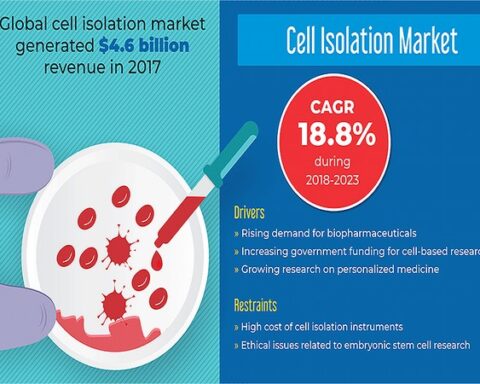The global ophthalmic drugs market is anticipated to grow moderately, at a CAGR of 4.2% during the forecast period (2020-2025). Visual impairments have increased across the world, owing to a multitude of factors. Varying in degree, visual impairments are a global health concern, affecting individuals physically and psychologically.
It is estimated that around 25% of the American population will suffer from cataract by 2020 while diabetic retinopathy patients will rise by nearly 20%. As a consequence, the demand for ophthalmic drugs is increasing. Moreover, rising FDA approvals for different drugs, such as Shire’s Xiidra, a lymphocyte function-associated antigen-1 (LFA-1) antagonist, are leveraging market prospects.
Key Takeaways of Global Ophthalmic Drugs Market Study:
- By disease indication, the retinal disorders segment is set to dominate the ophthalmic drugs market. A burgeoning pool of retinal disorder patients is projected to leverage the segment’s market share. It is estimated that the number of people afflicted by age-related macular degeneration (AMD) hall reaches 288 million by 2040. The projected market share of the retinal disorders segment is pegged at 4.7% in the forecast period. However, the glaucoma segment is set to soar in popularity. This is attributed to a rising pool of glaucoma patients and the presence of important glaucoma drug manufacturers such as Pfizer and Novartis. The glaucoma segment is set to grow staggeringly at a CAGR of 3.5%, capturing two-fifth of the market.
- By therapeutic class, the anti-glaucoma drugs segment is prophesied to capture a major chunk of the global ophthalmic drugs market. This is attributed to increasing prevalence, higher inclination towards combination methods, and rising initiatives for treatment penetration. Also, industrial focus on the development of glaucoma treatment drugs shall leverage the segment’s growth. Anticipated CAGR for anti-glaucoma drugs is 3.3% and a market share of over two-fifths.
- By product type, the over-the-counter drugs (OTC) segment is anticipated to be the most attractive of the global ophthalmic drugs market. OTC drugs are suitable for the treatment of seasonal infections such as conjunctivitis and dry eyes. These drugs also offer relatively short duration treatment. The OTC drugs segment shall dominate the global ophthalmological drugs market, accounting for more than half of the total market share.
- By distribution channels, independent pharmacies and drug stores are anticipated to expand rapidly at a CAGR of 4.8%, capturing a market share of more than half the total ophthalmological drugs market. The high growth rate is due to its convenience, security, electronic payment technology, and a wide range of available medications and services.
- By region, North America shall capture almost two-fifth of the global ophthalmological drugs market during the forecast period. This is attributed to the high cost of prescription drugs and the presence of key market players such as Novartis AG and F. Hoffmann- La Roche, Ltd. Asia-Pacific is anticipated to expand modestly at a CAGR of 4.9%, attributed to an increase in funding for research and the presence of key market players in the wake of a large patient pool.
“The global ophthalmic drugs market is set to grow positively in the future. The rising prevalence of visual impairments has encouraged important market players to establish drug formulation and development businesses in key regions. Their primary focus in on developing new formulations to improve market footprint,” concludes a Fact.MR analyst.
Global Ophthalmic Drugs Market: Leading Players to Constitute Three-fifths of the Market
The global ophthalmic drugs market is consolidated. The top four players constitute more than three-fifths of the market. These players are Novartis AG, Regeneron Pharmaceuticals, Inc., ALLERGAN and Santen Pharmaceutical Co., Ltd. These companies primarily concentrate on developing new drugs and innovating their development formula.
For example, Santen Pharmaceutical Co. and Singapore Eye Research Institute announced a strategic, five-year extended collaboration to develop new technologies for unmet medical needs in key ophthalmological domains in 2017. The company manufactures prescription drugs for corneal, retinal, and glaucoma diseases, which include Diquas, Tapros, Alesion, and Eylea. Novartis AG, another player, integrates new products into its existing pipeline of drugs. It specializes in innovative medicines and includes ophthalmic drugs products like Lucentis and Travoprost.
COVID-19 Insights:
The global ophthalmic drugs market demonstrates significant growth promises during the course of the COVID-19 pandemic. Recent studies have concluded that ocular transmission of the virus poses a great threat to non-infected persons. It has been established that COVID-19 patients develop eye irritation and conjunctivitis, thus requiring immediate attention. As a result, there has been an uptick in the demand for ophthalmic drugs across various healthcare settings. Fortunately, several countries have announced a partial lifting of lockdowns, allowing manufacturing capacities to resume at normal levels. Moreover, logistical arrangements such as inter-state and inter-country transportation of essential goods have also eased. This is expected to fill the gaps in the demand-supply equation which was present for the past few months.








